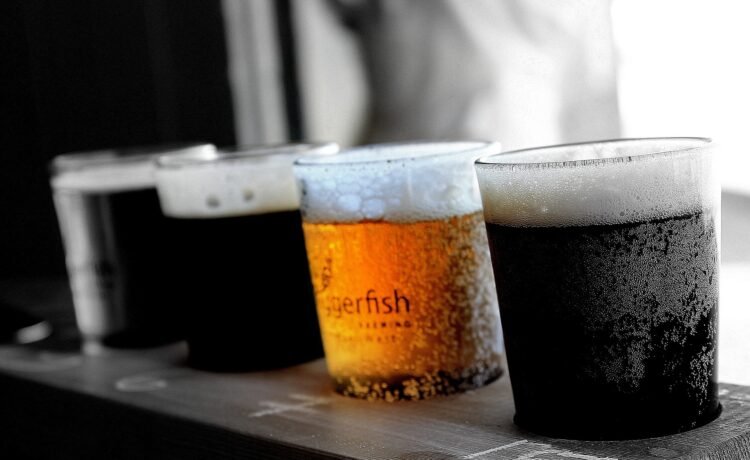Have you ever found yourself in a kitchen dilemma, staring at a recipe that calls for a pint of cream while you only have a metric measuring cup? Or maybe you’re hosting a gathering and want to serve the perfect amount of your favourite beverage? If you’ve asked yourself, How many ML in a pint? you’re in the right place!
We’ll dive into the nitty-gritty of conversions, why they matter, and how to master them like a pro. But first, let’s break down what a pint actually is and why understanding conversions can make a world of difference in your culinary adventures.
What is a Pint?
A pint is a unit of measurement commonly used to quantify liquids, primarily in the United States and the United Kingdom. In the U.S., a pint is defined as 16 fluid ounces, while in the UK, it measures 20 fluid ounces. This difference can be significant depending on the context, particularly when following recipes that may originate from either side of the pond.
Pints are a staple in many beverage serving sizes. You might find pints of beer at your favourite pub or pints of ice cream in the freezer aisle. Understanding this measurement is crucial not only for cooking and baking but also for enjoying your favourite drinks responsibly.
Why Conversions Matter
Conversions matter for several reasons, especially in the culinary world. First and foremost, precise measurements can be the difference between a delightful dish and a culinary disaster. If a recipe calls for a pint of milk but you miscalculate and pour a quart instead, the flavor and texture of your dish can be dramatically altered.
Furthermore, with the global nature of food and cooking today, recipes come from various sources that may use different measurement systems. Understanding how to convert between these systems—such as from pints to milliliters or ounces to cups—allows you to navigate recipes from different regions without fear of making a mistake.
Understanding Measurements
The Difference Between Fluid and Dry Measurements
When it comes to measurements, not all are created equal! The terms “fluid” and “dry” measurements can sometimes cause confusion. Fluid measurements, as the name suggests, are used for liquids, while dry measurements are typically used for solid ingredients.
For example, if you’re measuring flour for a cake, you would use dry measurements (like cups or ounces). On the other hand, if you’re pouring milk into a recipe, you’d use fluid measurements (like pints or milliliters). Understanding the difference is crucial, especially in cooking and baking, where precision can make or break a dish.
Standard Pint vs. Imperial Pint
Did you know that there are different types of pints? In the United States, a standard pint is equal to 16 fluid ounces, whereas the imperial pint used in the UK is slightly larger at 20 fluid ounces. This difference might seem minor, but when it comes to conversions, every ounce counts!
- US Pint: 1 US pint = 16 fluid ounces = 473.176 milliliters
- Imperial Pint: 1 UK pint = 20 fluid ounces = 568.261 milliliters
Knowing which pint you’re dealing with can help you avoid miscalculations and ensure your recipes turn out just right.
How Many ML in a Pint?
So, how many ML in a pint? The answer can vary based on which pint you’re using:
- Standard US Pint: 1 US pint = 473.176 ml
- Imperial Pint: 1 UK pint = 568.261 ml
It’s essential to know which measurement you’re working with to avoid any kitchen catastrophes!
Simple Calculation Method
If you ever need to do this conversion on the fly, here’s a quick formula to remember:
- For US pints: Multiply the number of pints by 473.176
- For imperial pints: Multiply the number of pints by 568.261
Conversions Explained
Tables for Quick Reference
Here’s a handy table to help you visualise the conversions:
| Measurement Type | US Pint (473.176 ml) | Imperial Pint (568.261 ml) |
| 1 Pint | 473.176 ml | 568.261 ml |
| 2 Pints | 946.352 ml | 1136.522 ml |
| 4 Pints | 1892.705 ml | 2272.104 ml |
| 8 Pints | 3785.41 ml | 4546.208 ml |
This table allows you to quickly reference conversions without needing to break out a calculator!
Other Common Conversions (Cups, Ounces)
Conversions can often lead to questions about other measurements. Here’s a quick reference:
- 1 Pint = 2 Cups
- 1 Pint = 16 Ounces
Having a grasp of these common conversions will make your cooking and baking adventures much smoother.
Practical Applications of Pint to Milliliters Conversion
When you’re cooking or baking, accurate measurements can mean the difference between a culinary masterpiece and a total flop. Here’s how you can apply pint-to-milliliter conversions in everyday cooking:
Cooking and Baking
Imagine you’re whipping up a delicious soup recipe that calls for 1 pint of broth. If you only have a milliliters measuring cup, knowing that 1 pint equals approximately 473 ml means you can easily get it right! It’s not just about following the recipe; it’s about understanding the underlying measurements to create the perfect dish.
Beverage Servings
Whether you’re pouring drinks at a party or measuring out ingredients for a cocktail, understanding how many ML in a pint helps you serve the perfect amount. Want to impress your friends with your cocktail-making skills? Now you can accurately measure out your ingredients like a pro!
Common Mistakes in Converting Measurements
As you dive into the world of measurements, here are a couple of common pitfalls to avoid:
Misunderstanding Fluid Ounces
Don’t confuse fluid ounces with dry ounces. This mix-up is more common than you might think and can lead to inaccurate conversions. Remember, fluid ounces measure volume, while dry ounces measure weight.
For instance, a cup of water and a cup of flour weigh different amounts, even though they take up the same volume!
Using the Wrong Pint Measurement
Always double-check whether you’re using a US pint or an imperial pint. It’s easy to forget, and that little slip can have a big impact! If you’re following a recipe from the UK, assume it’s using imperial measurements unless otherwise stated.

Tips for Accurate Conversions
Here are some tips to ensure you always get your conversions right:
Using Measuring Tools
Invest in good measuring tools! A reliable measuring jug can save you from a lot of guesswork. Look for ones that clearly indicate both metric and US measurements.
When to Double-Check Conversions
If you’re unsure, it’s always a good idea to double-check your conversions using a calculator or an app. It’s better to be safe than sorry, especially in the kitchen! There are also plenty of websites and mobile apps designed specifically for this purpose.
Real-Life Scenarios for Pint to Milliliters Conversion
Recipe Adjustments
Let’s say you have a recipe that serves 4, but you’re cooking for a larger crowd. By converting pints to milliliters, you can easily adjust your ingredient amounts without losing your mind! Just remember to keep the proportions consistent; this way, your dish remains delicious, no matter how many servings you need.
Home Brewing
For those adventurous enough to brew their own beer, precise measurements are crucial. Knowing How many ML in a pint can help you craft your perfect brew. Whether it’s measuring hops or determining the right amount of water, accuracy is key in brewing.
The Science Behind Measurement
Understanding the Metric System
The metric system is widely used around the world because of its simplicity and ease of conversion. Unlike the US customary system, which can feel a bit haphazard, the metric system operates on a base-10 system, making it straightforward to convert between units.
For instance, moving from milliliters to liters is as simple as dividing or multiplying by 1,000, which is much easier than trying to remember the various conversions in the US system!
Why Different Countries Use Different Systems
Have you ever wondered why different countries use different measurement systems? The answer often lies in historical preferences and regional standards. For example, the UK uses the imperial system for certain measurements, while the US relies more heavily on customary units. This variation can lead to confusion, especially for travellers or those following international recipes.
Additional Measurement Conversions
Gallons to Liters
If you’re expanding your conversion knowledge, you might also want to know that:
- 1 US gallon = 3,785.41 ml
- 1 UK gallon = 4,546.09 ml
Understanding how to convert between gallons and liters can be especially useful for larger recipes or bulk purchases.
Quarts to Milliliters
- 1 US quart = 946.353 ml
- 1 UK quart = 1,136.52 ml
These conversions can come in handy when you’re measuring larger quantities for parties or events.
Resources for Conversion
Online Conversion Tools
In today’s digital age, finding the right conversion tools is easier than ever. Websites like ConvertUnits or measurement conversion apps can help you make accurate conversions with just a few clicks. This way, you won’t have to rely solely on memory when it comes to measurements!
Mobile Apps for Measurements
There are various mobile apps available that can help simplify measurement conversions. Apps like “Kitchen Calculator” or “ConvertPad” are great options to keep on your smartphone, allowing you to convert measurements on the go!
FAQs About How many ML in a Pint
How do I convert milliliters to pints?
To convert milliliters back to pints, divide the number of milliliters by the appropriate conversion factor (473.176 for US pints, 568.261 for imperial pints).
Are there different types of pints?
Yes, the two main types are the US pint (16 fluid ounces) and the imperial pint (20 fluid ounces).
Why is knowing conversions important?
Understanding conversions is vital for accurate measurements in cooking, baking, and brewing, ensuring your recipes turn out as intended.
Can I use an online calculator for conversions?
Absolutely! There are many online calculators that can help you convert between different measurements quickly and accurately.
What are some common volume measurements?
Other common volume measurements include cups, ounces, liters, and gallons.
Conclusion
So, there you have it! The next time someone asks, How many ML in a pint? you’ll be ready to answer with confidence. Whether you’re cooking, baking, or mixing up your favourite drinks, mastering these conversions will elevate your culinary game.
By understanding the nuances of measurement systems and keeping handy references available, you’ll find that cooking can be both fun and precise. Remember, practice makes perfect, so don’t hesitate to use these tips and tricks in your kitchen adventures!










![[ozzmodz] forum prefix filter block 2.0.1](https://maxinstagramfollowers.com/wp-content/uploads/2024/09/desktop-1985856_1280-100x65.jpg)


